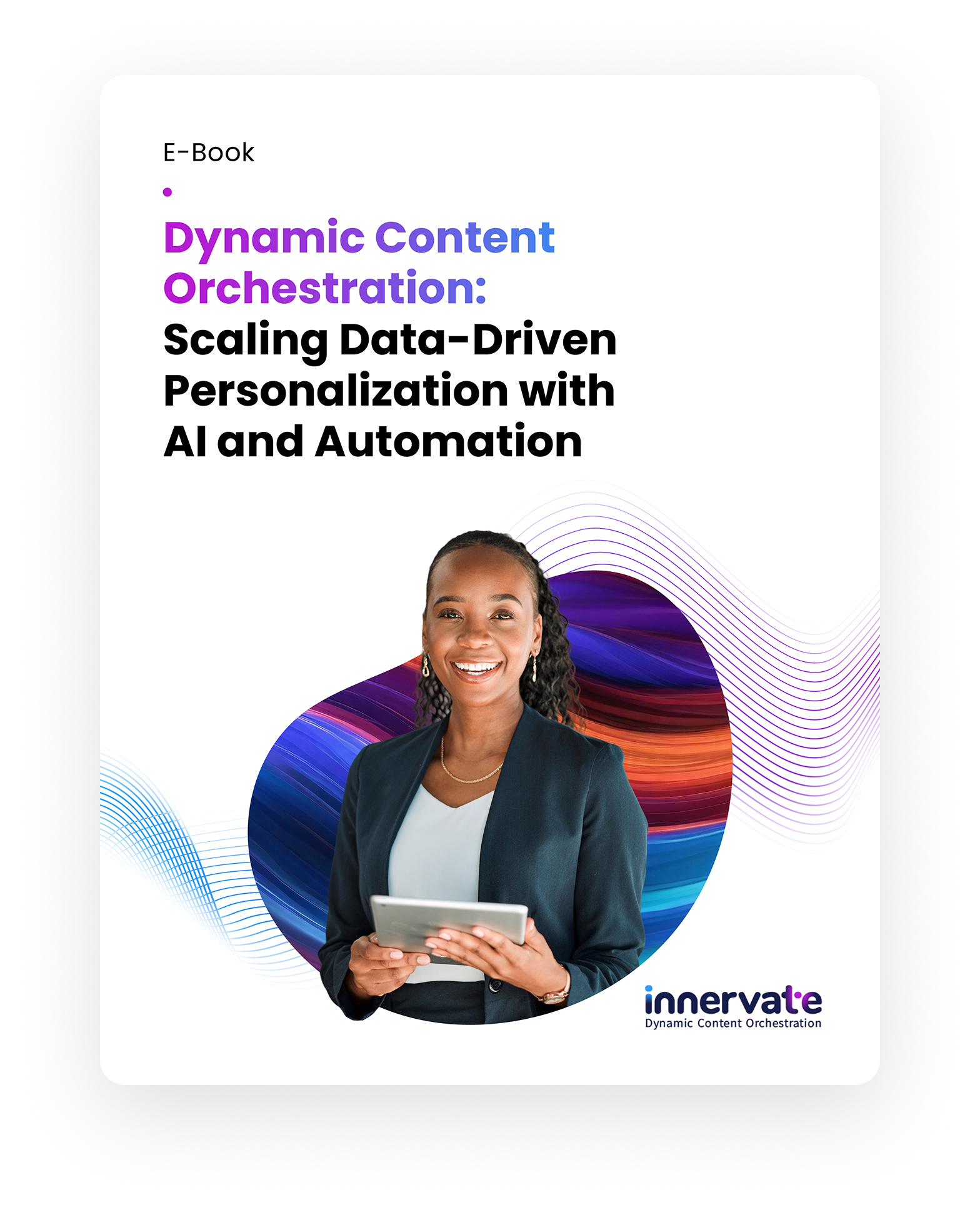Dynamic Content Orchestration:
Scaling Data-Driven Personalization
with AI and Automation
Improve personalization, speed to market, and cross-team collaboration—without
adding complexity.

Download a PDF version of this guide by filling out this form, or keep scrolling to learn more.

Introduction
Let’s set the scene.
Your customers expect tailored content. Your teams are already stretched thin. And your tech stack is complicated, chaotic, and cluttered with siloed point solutions that don’t always talk to each other.
Sound familiar? This is the behind-the-curtain reality for most industry leaders—but soon, you’ll have the solution you need to scale with far less stress.
Dynamic content is now central to modern marketing performance. But without strong workflows and intelligent automation, even the best personalization efforts can stall out, creating more inefficiencies than impact.
Dynamic content orchestration offers a smarter way forward. One in which automation is intentional, content adapts in real time, and your team gets back the control and speed they’ve been missing.
What Is Dynamic Content Orchestration?
Common Pitfalls in Dynamic Content Orchestration
The ROI of Orchestration: What Happens When You Get It Right
How to Make Orchestration Work: Real-World Best Practices
What Winning Orchestration Actually Looks Like

What Is Dynamic Content Orchestration?
Dynamic content orchestration is the strategic coordination of data, technology, and teams to deliver relevant content to the right audience, in the right channel, at exactly the right moment.
It’s how leading brands scale personalization without scaling complexity.
Doing this effectively involves making your existing systems, people, and processes work in harmony and using automation to activate your data in ways that are fast, smart, and sustainable.
Here’s Exactly What It Takes to Orchestrate Effectively
To turn personalization from a goal into a repeatable, scalable process, you need a few key ingredients. These include:
Real-Time Data Integration
Orchestration starts with data pulled from customer relationship management (CRM) systems, customer data platforms (CDPs), analytics platforms, and third-party sources. Bringing these signals together allows for more responsive, contextual content experiences.
Automation and AI Enablement
Intelligent automation makes orchestration simple and scalable. Use rule-based workflows and AI to drive decisioning, testing, delivery, and analysis without adding manual overhead.
Dynamic Segmentation and Targeting
Forget static personas. Dynamic orchestration relies on flexible AI-powered models that adapt based on customer behaviors, preferences, and triggers across channels.
Performance Measurement and Optimization
Effective dynamic content orchestration is an evolving process. With the right analytics, you can track what’s working, pinpoint bottlenecks, and continually refine for better outcomes.
And Here’s What Dynamic Orchestration Is Not
Even experienced teams fall into common traps.
Misunderstanding what orchestration really means can lead to wasted spend and underwhelming results. A few traps to avoid include:
More Tools = Better Results
Adding more software rarely solves the root issue. Without unifying workflows and data, you’re just adding complexity—and creating new silos to manage.
Personalization Is Just About Targeting
True personalization isn’t just knowing who to reach—it’s knowing when, where, and how to deliver content that performs. That requires cross-functional alignment, automation, and performance tracking.

Common Pitfalls in Dynamic Content Orchestration
Even with the best intentions and top-tier tools, many brands still hit a wall when trying to scale personalized content. Ineffective workflows, siloed teams, and under-leveraged data all make orchestration harder than it needs to be.
Here’s a rundown of the most likely obstacles standing in your way (and what you can do about them):
Investing in Tools Without Fixing the Foundation
It’s easy to assume the next platform you invest in will solve all your personalization problems. But without streamlining the internal mechanics of how content gets built, approved, and deployed, new tools just add to the chaos.
(Think, for example, of a brand using four different creative platforms across teams, with no shared process for asset reuse. Or a retail organization where every new channel gets its own standalone campaign.)
If your workflows can’t support fast, consistent cross-channel delivery, personalization will always feel one step behind.
Want to see what it looks like to build efficiency before tech bloat?
Check out this practical guide to decluttering your MarTech stack and freeing your team to focus on strategy—not system-switching.
Siloed Teams, Siloed Execution
When brand, display, email, social media, and in-store marketing teams aren’t operating from the same playbook, content orchestration becomes guesswork. Goals diverge, ownership blurs, and the customer experience suffers.
Consistency requires collaboration. That doesn’t mean scheduling more meetings—it means building intentional alignment into your personalization infrastructure (and constantly rechecking, rebuilding, and reinforcing that alignment.)
Are you curious how Nordstrom bridged gaps across teams?
Explore the company’s cross-functional approach to bringing media, email, and site teams under one dynamic content strategy.
Sitting on Gold—But Not Spending It
Brands often fall into the “data-rich, insight-poor” trap.
They know what a customer just clicked, searched, or bought—but their content can’t adapt because there’s no system in place to use that data immediately. Instead, insights are delayed, decisions are batched, and content lags behind customer intent.
Looking to make your data actually do something?
See how AI transforms dynamic content strategies by connecting live signals to drive dynamic content.

The ROI of Orchestration: What Happens When You Get It Right
Fixing fragmentation is a business and workflow win.
When dynamic content orchestration is done well, brands move smarter, personalize deeper, and optimize continuously.
Here are some of the potential benefits:
Increased Efficiency and Speed to Market
No more waiting weeks for content to be resized, rewritten, re-approved, and re-trafficked. With orchestration, you can launch channel-specific variations from a single source of truth—without breaking your creative ops team.
- Automation replaces redundant manual tasks such as resizing or reformatting creative for multiple channels.
- Pre-set rules allow content to adapt dynamically to audience data rather than relying on human intervention for every change.
- AI-powered workflows enable faster testing, faster rollout, and faster iteration.
Want to see this in action?
Explore how OTTO streamlined content production across channels and markets without increasing headcount.
More Relevant, Personalized Customer Interactions
Great content isn’t just personalized; it’s well-timed, well-placed, and contextually aware. Orchestration ensures your message reflects the moment, not just the persona.
- Dynamic creative optimization (DCO) ensures each asset adapts to real-time data, from location to browsing behavior to weather.
- Integrated systems allow for holistic storytelling across email, social, display, site, app, and in-store content.
- Personalization logic becomes scalable, so you’re not creating 50 versions manually—you’re defining the rules once, and letting the system build the rest.
Struggling to scale dynamic content without creative burnout?
Check out this breakdown of how to overcome common DCO challenges.
Smarter Measurement and Ongoing Optimization
Orchestration can help make every campaign you launch smarter over time.
With the right performance signals flowing back into your system, content becomes more effective by default.
- Real-time analytics allow you to measure engagement, conversion, and lift at the asset and audience level.
- A/B and multivariate testing help you zero in on what’s actually working faster than legacy test-and-learn cycles.
- You can track success across metrics such as:
- Percent of customer interactions personalized
- Time saved in content production
- Conversion rate lift tied to dynamic content
Need proof this works?
See how LendingTree uses data to personalize at scale, drive measurable lift, and iterate faster.

How to Make Orchestration Work: Real-World Best Practices
Even with the right tools, dynamic content orchestration won’t succeed without a solid strategic foundation.
Here's how high-performing teams can make this happen.
Start Small, Then Scale
One of the biggest orchestration mistakes is trying to do everything, everywhere, all at once.
The most successful teams identify a high-impact use case—like email or onsite personalization—and nail it before expanding.
- Pick one owned channel for dynamic content delivery.
- Test, iterate, and measure performance until it becomes a repeatable system.
- Once proven, replicate the approach across other teams, tools, or campaigns.
Need help deciding where to begin?
This guide to always-on creative experimentation breaks it down with real examples.
Let AI and Automation Augment (Not Replace)
Automation should never erase human judgment. The right orchestration strategy frees your team from repetitive tasks and gives them space to think, test, and build smarter.
Use automation and AI to:
- Generate content variants at scale based on data rules—not guesswork.
- Streamline review and compliance workflows without sacrificing control.
- Trigger real-time updates when behavior, context, or conditions change.
AI can personalize a headline. It can’t build a (good) brand voice. Orchestration works best when your teams stay at the center of the process.
Align Your Stakeholders
Even the most powerful orchestration platform will underdeliver if your internal teams aren’t on the same page.
The strongest orchestration strategies are built by cross-functional teams with shared goals—not siloed departments with competing KPIs.
- Appoint a centralized orchestration working group.
- Create a unified roadmap that accounts for IT systems, data flow, creative needs, and compliance.
- Make collaboration habitual, not heroic.

What Winning Orchestration Actually Looks Like
You don’t need more platforms. You need better coordination.
If you take nothing else with you from this guide, take this:
- Think beyond the tech stack. The best results come from fixing workflow friction, not piling on tools.
- Operationalize real-time personalization. If your data isn’t in motion, it’s just shelfware.
- Make optimization a habit. The best orchestration strategies are living systems—measured, iterated, and always evolving.
Ready to Orchestrate Smarter?
The gap between manual personalization and scaled orchestration doesn’t have to feel unbridgeable.
Innervate helps you build that bridge with a platform designed to streamline execution, maximize personalization, and empower your teams to move faster, together.
Want to see it for yourself? We’ve got you covered. Speak to a dynamic content expert today.
Download a PDF version of this guide by filling out the form.






